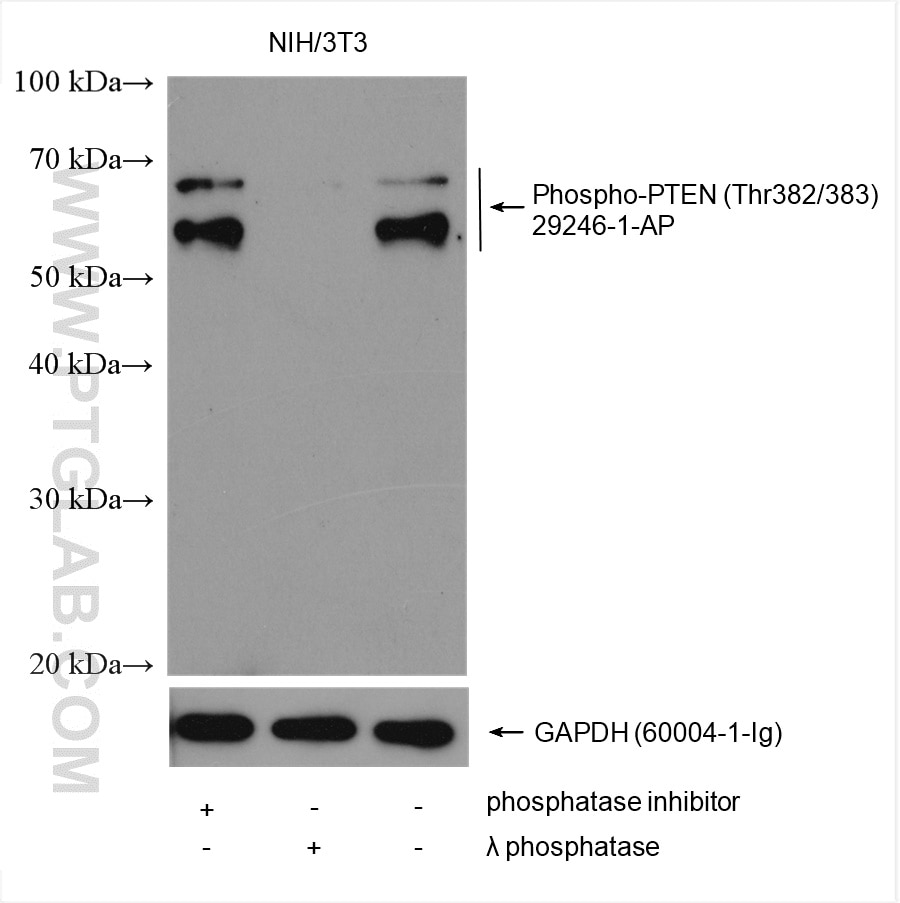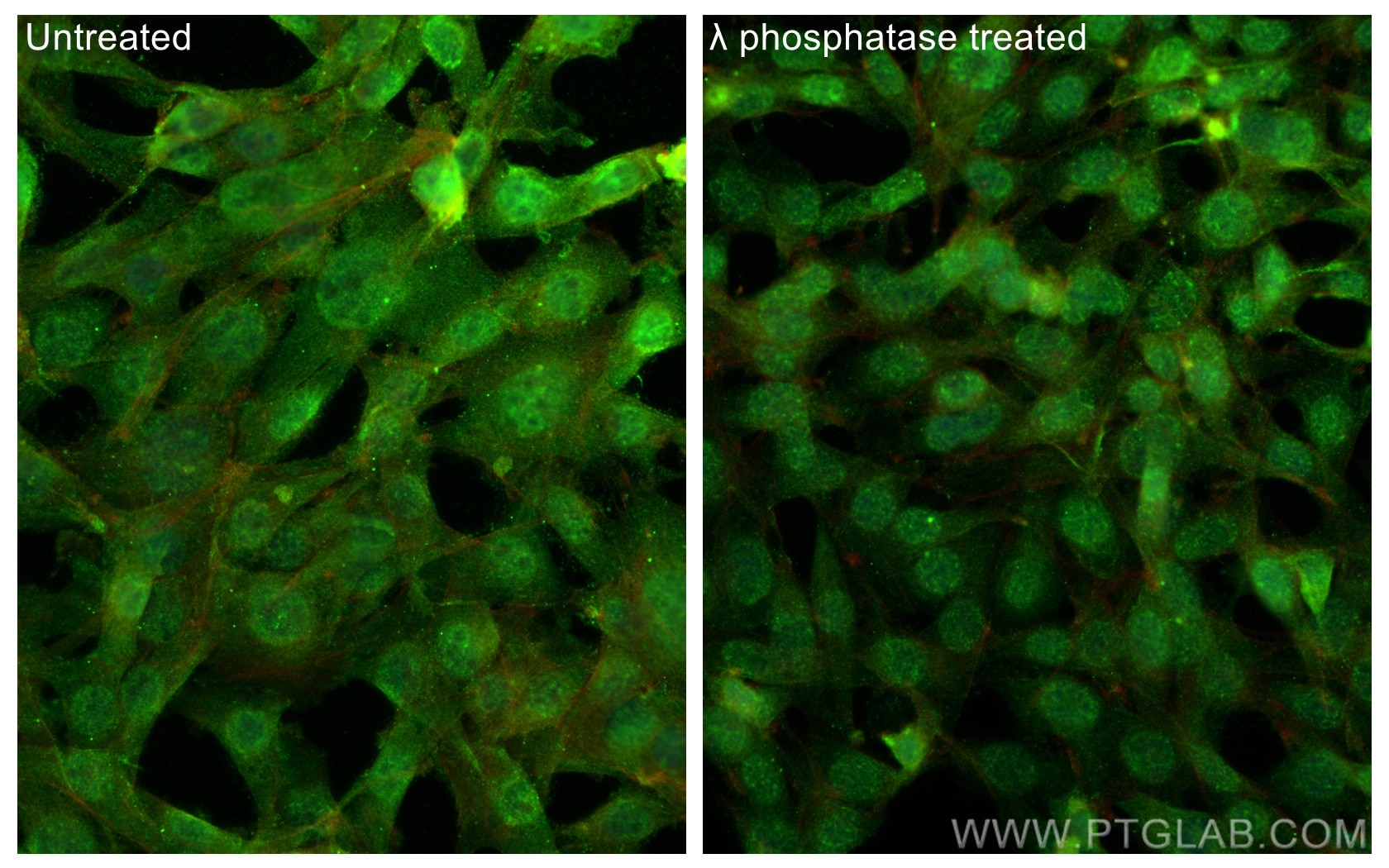Phospho-PTEN (Thr382/383) Polyklonaler Antikörper
Phospho-PTEN (Thr382/383) Polyklonal Antikörper für WB, IF/ICC, ELISA
Wirt / Isotyp
Kaninchen / IgG
Getestete Reaktivität
human, Maus und mehr (1)
Anwendung
WB, IF/ICC, ELISA
Konjugation
Unkonjugiert
Kat-Nr. : 29246-1-AP
Synonyme
Geprüfte Anwendungen
| Erfolgreiche Detektion in WB | NIH/3T3-Zellen, Mit λ-Phosphatase behandelte NIH/3T3-Zellen |
| Erfolgreiche Detektion in IF/ICC | Mit λ-Phosphatase behandelte NIH/3T3-Zellen |
Empfohlene Verdünnung
| Anwendung | Verdünnung |
|---|---|
| Western Blot (WB) | WB : 1:2000-1:10000 |
| Immunfluoreszenz (IF)/ICC | IF/ICC : 1:50-1:500 |
| It is recommended that this reagent should be titrated in each testing system to obtain optimal results. | |
| Sample-dependent, check data in validation data gallery | |
Veröffentlichte Anwendungen
| WB | See 7 publications below |
Produktinformation
29246-1-AP bindet in WB, IF/ICC, ELISA Phospho-PTEN (Thr382/383) und zeigt Reaktivität mit human, Maus
| Getestete Reaktivität | human, Maus |
| In Publikationen genannte Reaktivität | human, Hausschwein, Maus |
| Wirt / Isotyp | Kaninchen / IgG |
| Klonalität | Polyklonal |
| Typ | Antikörper |
| Immunogen | Peptid |
| Vollständiger Name | phosphatase and tensin homolog |
| Berechnetes Molekulargewicht | 47 kDa |
| Beobachtetes Molekulargewicht | 55-70 kDa |
| GenBank-Zugangsnummer | BC005821 |
| Gene symbol | PTEN |
| Gene ID (NCBI) | 5728 |
| Konjugation | Unkonjugiert |
| Form | Liquid |
| Reinigungsmethode | Antigen-Affinitätsreinigung |
| Lagerungspuffer | PBS with 0.02% sodium azide and 50% glycerol |
| Lagerungsbedingungen | Bei -20°C lagern. Nach dem Versand ein Jahr lang stabil Aliquotieren ist bei -20oC Lagerung nicht notwendig. 20ul Größen enthalten 0,1% BSA. |
Hintergrundinformationen
PTEN is one of the most critical tumor suppressors, which functions at different subcellular locations, including the plasma membrane and nucleus. The PTEN protein is located at different subcellular regions-PTEN at the plasma membrane suppresses PI3-kinase signaling in cell growth, whereas PTEN in the nucleus maintains genome integrity. At the plasma membrane, PTEN counteracts PI3 kinase signaling by dephosphorylating the potent second messenger PIP3 to PIP2. The loss of PTEN in cancer cells results in over-activation of AKT and mTOR signaling, leading to excessive stimulation of cell growth and inhibition of cell death. In the nucleus, PTEN functions in DNA repair, genome stability, and cell cycle control through associations with Rad51 and p53. PTEN stability is primarily regulated by phosphorylation of C-terminal tail domains (Thr366, Ser370, Ser380, Thr382, Thr383, and Ser385). The phosphorylation leads to a "closed" state of PTEN and maintains PTEN stability. Dephosphorylation of the C-terminal tail opens the PTEN phosphatase domain, thereby increasing PTEN activity. PTEN protein is of the apparent molecular mass expected for PTEN (55 kDa) and PTENα (70 kDa).(PMID: 33083717, PMID: 20622047, PMID: 24768297)
Protokolle
| PRODUKTSPEZIFISCHE PROTOKOLLE | |
|---|---|
| WB protocol for Phospho-PTEN (Thr382/383) antibody 29246-1-AP | Protokoll herunterladen |
| IF protocol for Phospho-PTEN (Thr382/383) antibody 29246-1-AP | Protokoll herunterladen |
| STANDARD-PROTOKOLLE | |
|---|---|
| Klicken Sie hier, um unsere Standardprotokolle anzuzeigen |
Publikationen
| Species | Application | Title |
|---|---|---|
Cell Rep Activation of GPR44 decreases severity of myeloid leukemia via specific targeting of leukemia initiating stem cells | ||
EMBO Rep LINC00493-encoded microprotein SMIM26 exerts anti-metastatic activity in renal cell carcinoma | ||
J Transl Med The miR-15b-5p/miR-379-3p-FOXO axis regulates cell cycle and apoptosis in scleral remodeling during experimental myopia | ||
Phytomedicine Rosmarinic acid attenuates glioblastoma cells and spheroids' growth and EMT/stem-like state by PTEN/PI3K/AKT downregulation and ERK-induced apoptosis | ||
Apoptosis CCDC134 enhances ovarian reserve function and angiogenesis by directly interacting with INHA in a mouse model of premature ovarian insufficiency | ||
Phytomedicine Isovitexin alleviates hepatic fibrosis by regulating miR-21-mediated PI3K/Akt signaling and glutathione metabolic pathway: based on transcriptomics and metabolomics |



